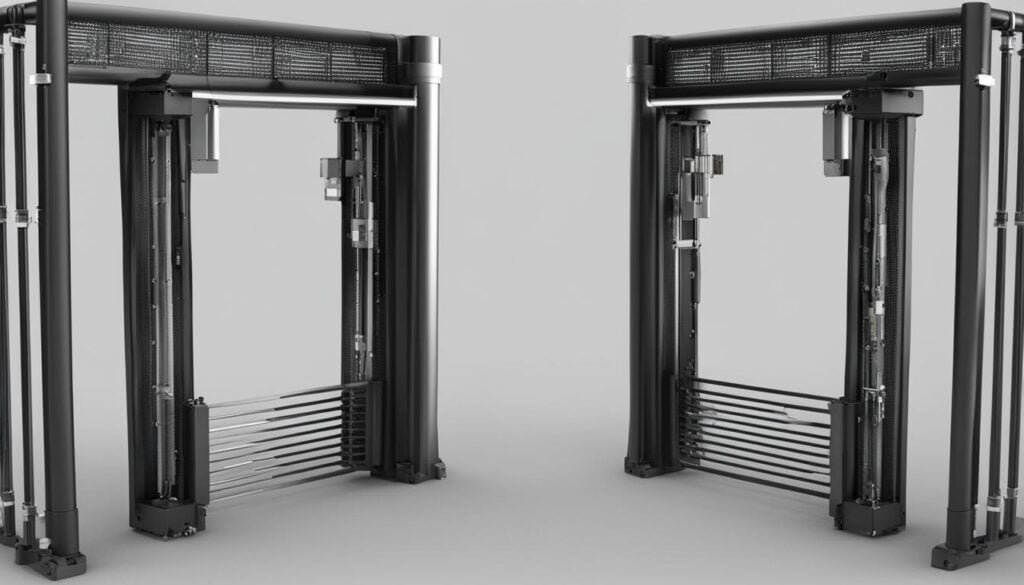When it comes to gate security systems, automatic gate sensors play a crucial role in ensuring the safety and convenience of entering and exiting a property. But have you ever wondered how do automatic gate sensors work? How are they able to detect and respond to any activity near the gate?
Automatic gate sensors come in various types, each with its own functionality and benefits. From infrared sensors to magnetic and electromechanical sensors, each type operates differently to provide the necessary surveillance and control. In this article, we will explore the different automatic gate sensor types and discover how they function to enhance gate security.
Key Takeaways:
- Automatic gate sensors are essential for gate security systems.
- There are different types of automatic gate sensors available.
- Infrared sensors are known for their high accuracy and efficiency.
- Magnetic and electromechanical sensors create a magnetic field to detect the presence of vehicles or people.
- Touch sensors are convenient for people with disabilities as they can be activated with a simple touch.
How Do Infrared Sensors Work?
Infrared sensors are an essential component of automatic gate systems, providing reliable motion detection and enhancing gate security. These sensors operate using a transmitter and a receiver to detect and respond to the presence of objects or individuals near the gate.
The transmitter emits invisible infrared light beams, which bounce back to the receiver. When an obstacle interrupts these infrared beams, the sensor promptly activates the gate, preventing any potential collisions. This makes infrared sensors highly accurate and efficient in detecting not only motion but also changes in heat and light.
By utilizing infrared technology, automatic gate systems equipped with infrared sensors can effectively monitor the gate’s surroundings and ensure the safety of vehicles and pedestrians entering or exiting a property. Whether it’s a residential driveway or a commercial entrance, these sensors provide the necessary reliability and precision.
Infrared sensors are widely recognized for their superior performance in motion detection, making them a popular choice for various security applications. Their ability to reliably detect movement and trigger gate activation provides peace of mind, knowing that unauthorized access is deterred and safety is prioritized.
Here is an image showcasing the functionality of infrared sensors in automatic gate systems:

“Infrared sensors are the backbone of modern automatic gate sensors, offering accurate and efficient motion detection capabilities.” – Gate Security Solutions
How Do Magnetic and Electromechanical Sensors Work?
Magnetic and electromechanical sensors are essential components of automatic gate systems. These sensors utilize the principles of magnetism to detect the presence of vehicles or individuals, ensuring safe and efficient operation.
Magnetic sensors make use of a metal detector loop that is embedded in the driveway. When a vehicle or person passes over the loop, it detects changes in the magnetic field and sends a signal to the control panel. This signal then triggers the automatic gate to open or close accordingly, providing seamless access control.
Electromechanical sensors function by creating a magnetic field through the use of a semiconductor. When a vehicle or person enters the sensor’s range, it detects the change in the magnetic field and sends a signal to the control panel. The control panel then activates the gate, allowing for smooth vehicle detection and gate operation.
Advantages of Magnetic and Electromechanical Sensors
- Accurate vehicle detection: Magnetic and electromechanical sensors are highly accurate in detecting the presence of vehicles or individuals, ensuring reliable gate operation.
- Cost-effective solution: These sensors offer a cost-effective solution for vehicle detection, making them a popular choice for residential and commercial automatic gate systems.
- Low maintenance: Magnetic and electromechanical sensors require minimal maintenance, providing long-term functionality without significant upkeep.
- Compatibility: These sensors can be easily integrated with various types of automatic gate systems, offering flexibility and compatibility.
To summarize, magnetic and electromechanical sensors play a crucial role in automatic gate systems by utilizing magnetic fields for accurate vehicle detection. These sensors offer numerous benefits such as accuracy, cost-effectiveness, low maintenance, and compatibility. Their reliable performance ensures the smooth operation of the automatic gate, providing enhanced security and convenience for property owners.

How Do Touch Sensors Work?
Touch sensors are a crucial component of automatic gate systems, providing accessibility and convenience for people with disabilities. These sensors are activated with the gentlest touch of a finger, elbow, or knee, making them easily operable for individuals with limited mobility.
The functionality of touch sensors relies on a micro-switch that triggers the gate operator when pressed. This switch is connected to a plate on the surface of the gate post, allowing users to activate the gate effortlessly with a simple touch.
By integrating touch sensors into automatic gate systems, property owners can significantly enhance the accessibility and ease of use for everyone, regardless of their physical abilities. These sensors ensure that entering and exiting the property is convenient and efficient, contributing to a more inclusive environment.
How Do RFID Sensors Work?
RFID sensors, an integral part of automatic gate systems, provide effective access control for properties, ensuring only authorized individuals can enter. These sensors utilize a unique ID badge that is compatible with an RFID reader, allowing efficient identification and granting access to approved personnel.
When triggered by the RFID reader, the sensor generates a magnetic field that activates the automatic gate as soon as the ID badge is detected. This seamless process ensures a smooth entry and exit experience for authorized individuals, reducing the risk of unauthorized access and enhancing security measures.
RFID sensors are widely utilized across various industries and sectors, including residential complexes, commercial buildings, and gated communities. Their ability to accurately identify individuals and swiftly grant or deny access makes them an essential component of modern access control systems.
Moreover, RFID sensors enable tracking of frequent visitors, providing valuable data and insight into property usage. This information helps property owners or managers make informed decisions regarding visitor management and security protocols, thereby improving overall operational efficiency and security measures.
With their advanced technology and reliable functionality, RFID sensors play a vital role in maintaining access control and ensuring the security of both residential and commercial properties.
Conclusion
Automatic gate sensors are essential for enhancing gate security systems, providing accurate and efficient detection of motion and objects, ensuring the safety and convenience of entering and exiting a property. When it comes to choosing the right type of sensor, it is important to consider specific requirements and preferences.
Infrared sensors are the ideal choice for those who prioritize quick response times. These sensors are highly accurate and efficient, making them suitable for driveways or gates that require immediate activation. On the other hand, magnetic and electromechanical sensors offer a cost-effective option for detection, relying on the creation of a magnetic field to identify the presence of a vehicle or person.
For individuals with disabilities, touch sensors provide accessibility and convenience. With a simple touch of a finger, elbow, or knee, these sensors can be activated, ensuring an inclusive experience for all users. Additionally, RFID sensors offer control over access and visitor tracking by utilizing unique ID badges that interact with an RFID reader.
To maintain the effectiveness and longevity of gate sensors, proper installation, troubleshooting, and maintenance are essential. Regular inspection and cleaning of the sensors, as well as checking for any wiring or connectivity issues, will ensure their reliable performance. Professional help should be sought when encountering any troubleshooting problems to prevent further complications.
By understanding the benefits of gate sensors, following proper installation procedures, and implementing regular maintenance, property owners can fully maximize the security and convenience offered by these essential devices.
FAQ
How do automatic gate sensors work?
Automatic gate sensors detect and respond to activity near the gate. They include infrared sensors, magnetic and electromechanical sensors, touch sensors, and RFID sensors that function based on different principles such as infrared light beams, magnetic fields, touch activation, or RFID card detection.
What are the types of automatic gate sensors?
The types of automatic gate sensors include infrared sensors, magnetic sensors, electromechanical sensors, touch sensors, RFID sensors, and loop detectors.
How do infrared sensors work?
Infrared sensors use a transmitter and a receiver. The transmitter emits invisible infrared light beams, which bounce back to the receiver. When an obstacle interrupts the beams, the sensor activates the gate to avoid collision.
How do magnetic and electromechanical sensors work?
Magnetic sensors have a metal detector loop embedded in the driveway. They detect changes in the magnetic field when an object passes over it. Electromechanical sensors use a semiconductor to create a magnetic field and send a signal to the control panel to activate the gate.
How do touch sensors work?
Touch sensors are activated with a simple touch of a finger, elbow, or knee. They work with a micro-switch that triggers the gate operator when pressed. The switch is connected to a plate on the surface of the gate post, enabling convenient use.
How do RFID sensors work?
RFID sensors function with a unique ID badge that is compatible with an RFID reader. When the reader is triggered, it creates a magnetic field that activates the automatic gate upon detecting the ID badge.
What are the benefits of gate sensors?
Gate sensors enhance gate security systems by providing accurate and efficient detection of motion and objects. They ensure the safety and convenience of entering and exiting a property. Additionally, specific sensor types offer accessibility for people with disabilities, control over access, or visitor tracking.
How do I install gate sensors?
Gate sensor installation instructions vary depending on the specific sensor type and the manufacturer. It is recommended to refer to the user manual provided by the manufacturer for detailed installation guidance.
What should I do if my gate sensor is not working?
If your gate sensor is not working, start by checking the power supply and connections. Ensure that the sensor is properly aligned and not obstructed by any objects. Consult the troubleshooting section of the user manual or contact the manufacturer for further assistance.
How do I maintain my gate sensors?
Proper gate sensor maintenance involves periodic cleaning to prevent dirt or debris from obstructing the sensor’s functionality. Regularly check the alignment and connections to ensure optimal performance. Refer to the manufacturer’s guidelines for specific maintenance recommendations.
